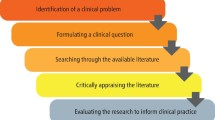Abstract
The information explosion has affected the medical as well as the lay press. Sources of literature have never been so diverse, and freedom of information legislation globally has empowered all and sundry to voice their views on all matters. This freedom is exercised with regard to medical literature in general and Women’s Health publications in particular. The implicit requirement for clinical practice to be informed by evidence (evidence-based medicine) has placed the onus on the readership of clinical literature to acquire skills in appraising such literature. The need to sift out relevant information from the burgeoning obstetrics and gynaecology literature has mandated the acquisition of skills in critical literature appraisal. This review outlines how to critically appreciate and evaluate literature generally, and as it relates to obstetrics and gynaecology.


Similar content being viewed by others
References
Sackett DL, Richardson WS, Rosenberg WMC, Haynes RB (1997) Evidence-based medicine: how to practice and teach EBM. Churchill-Livingstone, London
MacAuley D (1994) READER: an acronym to aid critical reading by general practitioners. Br J Gen Pract 44:83–85
MacAuley D, McCrum E, Brown C (1998) Randomised controlled trial of the READER method of critical appraisal in general practice. BMJ 316:1134–1137
The Cochrane Collaboration (2005) The Cochrane Library Issue 4, Wiley
Straus SE, Sackett DL (1998) Using research findings in clinical practice. BMJ 317:339–342
Guyatt GH, Rennie D (eds) (2002) The Evidence-Based Medicine Working Group. In: Users’ guides to the medical literature: a manual for evidence-based clinical practice. AMA, Chicago
Crombie IM (1996) The pocket guide to critical appraisal. BMJ, London
Fletcher RH, Fletcher SW, Wagner EH (1996) Clinical epidemiology: the essentials, 3rd edn. Williams and Williams, Baltimore
Greenhalgh T (1997) How to read a paper. BMJ, London
Pitkin RM, Branagan MA, Burmeister LF (1999) Accuracy of data in abstracts of published research articles. JAMA 281(12):1110–1111
Wilson P (2002) How to find the good and avoid the bad or ugly. A short guide to tools for rating quality of health information on the Internet. BMJ 324:598–602
Author information
Authors and Affiliations
Corresponding author
Rights and permissions
About this article
Cite this article
Anumba, D.O. Critical appraisal of the literature—its role in CPD. Eur Clinics Obstet Gynecol 1, 245–250 (2006). https://doi.org/10.1007/s11296-006-0018-9
Received:
Accepted:
Published:
Issue Date:
DOI: https://doi.org/10.1007/s11296-006-0018-9




